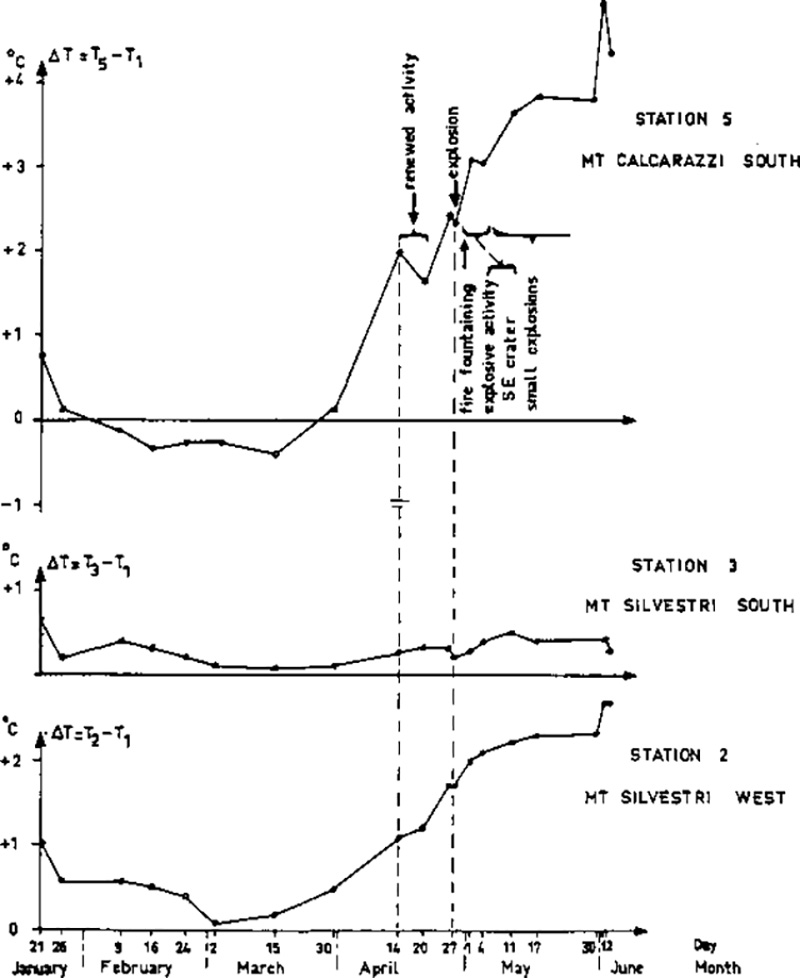Report on Etna (Italy) — May 1980
Scientific Event Alert Network Bulletin, vol. 5, no. 5 (May 1980)
Managing Editor: David Squires.
Etna (Italy) Incandescent tephra ejected; temperature anomaly on S flank
Please cite this report as:
Global Volcanism Program, 1980. Report on Etna (Italy) (Squires, D., ed.). Scientific Event Alert Network Bulletin, 5:5. Smithsonian Institution. https://doi.org/10.5479/si.GVP.SEAN198005-211060
Etna
Italy
37.748°N, 14.999°E; summit elev. 3357 m
All times are local (unless otherwise noted)
"After a 3-month period of stabilization, ground temperatures in Etna's S-flank fissure zones (6 km S of the summit) began to increase again in March (figure 8). However, station 3, only 25 m from station 2, continued to show a nearly constant temperature. Variations in temperature are calculated by comparison with Sapienza reference station 1, located outside the fissure zones, 0.5 km WNW of stations 2 and 3, and 1.25 km from station 5.
 |
Figure 8. Differences between ground temperature measured at 120 cm depth at stations 2, 3, and 5, and reference station 1 (T2-T1, T3-T1, and T5-T1) on Etna's S-flank, 21 January-2 June 1980. |
"The increase in temperature preceded renewed activity from the summit crater system. On 14 April, red-hot gases were emitted from the Southeast Crater and on the following days fresh lava lumps were ejected from the Chasm.
"On 20 April, S flank temperatures were stationary or even slightly lower. Between 20 April and 1 May, temperatures strongly increased again. A large explosion on 27 April (probably at Bocca Nuova) and strong lava fountaining on 29 April at the Southeast Crater were followed by moderate magmatic activity until at least 3 May. After a short period of stabilization (1-4 May), temperatures were still increasing, although more slowly.
[Archambault, Stoschek, and Tanguy added the following paragraph to replace explanatory material excised from 5:1]. "It was initially believed that the thermal anomaly fluctuations were related to the reopening of cracks caused by increases in volcanic pressure. Further investigations showed this hypothesis to be incorrect, with the systematic seasonal increase of surficial temperatures being mainly the consequence of a microclimate (Bourlet and Bourlet, 1982). A volcanic effect does occur, but its influence cannot be simple and is probably linked to the circulation of hot waters through the S flank. From this standpoint, a striking example is the rapid temperature increase measured in November 1982 at 6 m depth (figure 8, 08:04), where a climatic effect cannot be invoked. Such a variation was not observed the following years (November 1983 and 1984). It may have resulted from the heating of meteoric waters by an intrusion of magma into the S flank a few months before the March 1983 eruption.
"The Southeast Crater was intermittently active throughout May. On 31 May, two vents were observed inside the crater with moderate ejections of incandescent magmatic material up to 50 or 100 m, with some bursts occasionally reaching 200 m. As of 3 June, activity had increased noticeably, and explosions were stronger and more frequent. The number of explosions per hour reached 165 and the ejecta reached heights of 200-300 m."
References. Bourlet, Y. and Bourlet, F., 1982, Etude microclimatique de 5 stations sur le versant sud de l'Etna: Bull. PIRPSEV, no. 63.
Bourlet, Y. and Bourlet, F., 1983, Etude des anomalies thermiques et hydriques sur le versant NE à Citelli et sur le versant sud à la Montagnola: Bull. PIRPSEV, no. 73.
Geological Summary. Mount Etna, towering above Catania on the island of Sicily, has one of the world's longest documented records of volcanism, dating back to 1500 BCE. Historical lava flows of basaltic composition cover much of the surface of this massive volcano, whose edifice is the highest and most voluminous in Italy. The Mongibello stratovolcano, truncated by several small calderas, was constructed during the late Pleistocene and Holocene over an older shield volcano. The most prominent morphological feature of Etna is the Valle del Bove, a 5 x 10 km caldera open to the east. Two styles of eruptive activity typically occur, sometimes simultaneously. Persistent explosive eruptions, sometimes with minor lava emissions, take place from one or more summit craters. Flank vents, typically with higher effusion rates, are less frequently active and originate from fissures that open progressively downward from near the summit (usually accompanied by Strombolian eruptions at the upper end). Cinder cones are commonly constructed over the vents of lower-flank lava flows. Lava flows extend to the foot of the volcano on all sides and have reached the sea over a broad area on the SE flank.
Information Contacts: J. Tanguy, Univ. de Paris VI; C. Archambault and J. Stoschek, CNET, Lannion, France; G. Scarpinati, Acireale (direct measurements and observations); PIRPSEV, CNRS/INAG, France.

